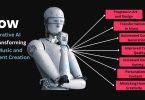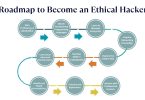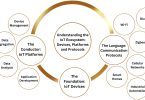Today in the age of information we live in the data-driven reality, where information flows as if it is an uncontrollable river. And this information river overflows storage and analysis continuously. This overwhelming avalanche, appropriately dubbed “big data”, has raised issues but also has enormous potential. To invoke this enormous space and acquire meaningful outcomes, we resort to complex algorithms; the faceless heroes of the rapidly expanding data era. Let’s proceed with the top 6 big data algorithms; the mystery around them will be explored and their effectiveness to positively affect several industries will be revealed here today.
Information is a field of data points for millions/billions of customers spread in all directions around the globe. K-means clustering plays as a skillful shepherd who groups these data points into several clusters based on their similarity. This unsupervised algorithm does an excellent job in “customer segmentation”, and “searching trends” of product preferences and “behavior”.
Take a fashion retailer as an example segmenting their customers using K-means based on purchase history and allowing specific marketing campaigns to customers from distinct segments.
-
Logistic Regression
It predicts the likelihood of an occurrence, such as voting or abstaining, based on a group of autonomous factors and the accompanying dataset.
Have you ever considered what truly determines the triumph or downfall of a marketing initiative? In this regard, logistic regression leads the way and uses huge datasets. This kind of supervised learning works like a fortune teller, relying on historical data to predict the results of the future events. Consider a bank processing loan applications from various clients with the help of logistic regression which will lead to low risk and prudent lending.
-
Random Forest
Random forest is a popular machine learning algorithm coined by “Leo Breiman” and “Adele Cutler” and involves predicting by combining predictions derived from a bunch of decision trees. The main features of it are “simplicity” and “flexibility” which fuel its adoption because it handles both classification and regression problems.
In a jungle full of trees, we could compare all the individual decision rules. The term “random forest” suggests its methodology, relying on a collection of decision trees to provide robust predictions. This algorithm is supervised learning but works well with complex data, providing high precision.
Visualize that the provider of healthcare uses random forests to figure out patient readmission risks and then he/she can start to undertake proactive interventions and provide better care for the patient.
-
Support Vector Machines (SVMs)
SVMs are a collection of supervised learning methods used for classification, regression and outlier detection. They excel in high-dimensional spaces, proving valuable when the dimensionality exceeds the sample size.
Imagine data points as soldiers in an intense classification conflict. SVMs work as generals, outlining separate borders among different classes that are characterized by their attributes. This algorithm that utilizes supervised learning is particularly suitable for highly dimensional data and intricate classification.
A self-effacing car using SVMs to classify pedestrians from vehicles, making sure the car is safe and accurate.
-
Naïve Bayes
The Naive Bayes classifier is a supervised machine learning algorithm intended for classification purposes, such as “text classification”. It is also a key member of the family of generative learning algorithms that aim to model the input distribution of a specific class or category.
Mostly Naive Bayes Algorithms are used for “Sentiment Analysis”, “Spam Filtering”, and “Recommendation Systems” etc. They are faster and easy to implement but their main drawback is that the assumption of independence of predictors is a necessary thing.
Envision the detective solving a crime by interpreting clues and evaluating evidence together with the likelihood of the given situation. Naive Bayes is of similar function in that it divides the data points by the probability of their features belonging to any of the classes. The advantages of the fast and efficient algorithm are that it suits both structured and unstructured data.
-
Apache Spark
It is a distributed computing system that is open-source, featuring a collection of libraries tailored for developing big data workloads. It employs “in-memory data caching” and “optimized querying” that generate analytics with the fastest speed and for data of any size.
Apache Spark can be a part of a much anticipated “ETL” game changer. Automation of data pipelines lets an organization to make faster data-driven decisions.
Apache Spark is the engine, a distributed processing framework designed for high-speed and scalability. It performs real-time analytics on huge data volumes across multiple machine clusters.
Beyond the Top 6 Data Algorithms
This list only covers the tip of the iceberg since there are other big data algorithm types out there. Other noteworthy algorithms include…
Deep Learning: Spurred on by the human brain these algorithms perform well in the areas of complex pattern recognition and natural language processing.
Gradient Boosting: This method creates a prediction machine that is based on several weak learners that are often better than each individual algorithm.
Apriori Algorithm: Using this rule-based algorithm, the emergence of hidden connections and frequent patterns are discovered in large datasets, enabling market basket analysis and recommendation systems.
Choosing the Right Algorithm
The optimal algorithm for your particular requirements relies on various factors, several of which are outlined below…
- Data type: Content with the format of “structured”, “unstructured”, or “semi-structured”?
- Problem type: Are they going to conduct “classification”, “regression”, “clustering”, or anomaly detection?
- Data size and complexity: Is it “small’, “medium”, or “large datasets”?
- Computational resources: Can it be compute-intensive and require large-scale storage?
Through these elements and the studying of the algorithms, one can reveal the true power of big data and acquire useful insights that will guide decision-making. The growth of “volume”, “variety” and “velocity” of data will be accompanied by the need for advanced algorithms to draw out this value. The algorithms discussed in this section are the top 6 and they are very useful but do not forget that they are just the tip of the iceberg. By venturing “deeper”, “testing” and “picking” the right tools, you can find the beast of big data to address complex issues, discover new opportunities and reimagine your organizations.








Leave a Comment